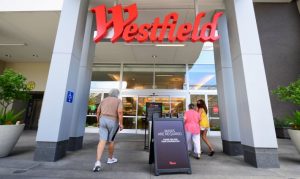A mall can’t catch a virus, but COVID-19 still could kill
hundreds of U.S. shopping centers if vacancy rates keep rising, a
recent report by Barclays Investment Bank said.
“Retailers have been losing foot traffic for years as
e-commerce takes an increasing share of sales,” Barclays
reported. “COVID-19 has sharply accelerated this trend.”
Fifteen percent of mall stores have closed this year, the report
says. If that trend persists, 15-17% of malls will fail and may
need to be redeveloped for other uses.
And the most likely uses — such as low-density residential or
e-commerce warehouses — won’t be as valuable as the former
malls, impacting local government revenue.
We asked retail consultant Greg Stoffel how that trend is
playing out in Southern California.
Q: What happens to ghost malls after the shoppers
vanish?
A: In many cases, these malls are poorly
located, out of the mainstream and have succumbed over time to
centers that are better located and have better quality stores,
restaurants and anchors.
Even before COVID-19, and before online shopping became
prominent, there were too many shopping centers of all kinds
relative to actual buying power in most market areas. Over time,
many of these centers tend to lose quality tenants and replace them
with tenants who lack the ability to generate customer traffic.
Q: What Southern California malls already have been or
are being redeveloped?
A: Indio Fashion Mall,�Hawthorne Plaza Mall,
the Carousel Mall in San Bernardino, The Quad and Whittwood malls
in Whittier, Laguna Hills Mall (which is being rebranded as the
Village at Laguna
Hills), Valley Plaza in North Hollywood, The City Shopping
Center in Orange (which became The Block at Orange and then
re-positioned as The Outlets at
Orange), and Riverside Plaza.
Q: How are they are being reused?
A: Most owners and potential developers look to
a combination of non-retail uses. This includes residential,
office, mixed-use developments, fulfillment centers, etc., that
include a little of everything like retail, dining and
entertainment.
A good example is Westminster Downtown in
Westminster, Colorado. What was a ghost mall was largely demolished
and is now being re-developed as a mixed-use downtown with
residential, hotels and offices with dining, entertainment and
retail on the ground floor.
Q: How are redeveloped malls in our region being
reused?
A: The Village at Laguna Hills (briefly called
the Five Lagunas) will be the most dramatic. The mix will include a
hotel, office space, apartments and retail and dining and a large
movie theatre (depending on the future of movie-going).
Hawthorne Plaza closed in 1999 and still sits empty. Various
plans have been proposed for the property but nothing has happened
so far.
Riverside Plaza was originally an open-air center that was
remodeled into an enclosed center. Due to department store
closures, the center was remodeled into an open-air center again.
Today it has Trader Joe’s, Vons Grocery, Regal Cinemas, Nordstrom
Rack and several restaurants.
Q: Which Southern California Malls are at most risk of
closing due to COVID-19?
A: I am not sure that any malls would close
based only on the impact of COVID-19. The pandemic may accelerate
the demise of a center or two, but there were likely already
problems in generating sufficient sales.
Gregory
Stoffel is a retail analyst who’s spent years analyzing malls in
California. (Courtesy of Stoffel)
Q: Barclays said some of the new developments aren’t
as valuable as malls, with valuations dropping 60-90%. Is that the
case here?
A: If a bad mall can’t be redeveloped with a
mixture of uses, yes the property values will decline.
This decline was likely already in process with taxable sales
declining due to changing consumer preferences and patronage
patterns. Cities are trying to hold on to whatever taxable sales
can be generated and sometimes have unrealistic ideas on what a
property can generate in the future.
Q: Looking 10 to 20 years down the road, will malls like
South Coast Plaza, Fashion Island, the Beverly Center and Ontario
Mills still be around? If so, how will they be different than
today?
A: Most malls will need to downsize their
retail space as customer shopping patterns continue to evolve.
There will be more of a premium on experience as well as unique
merchandise.
Millennials will be older and Gen Z customers will have a big
influence on shopping, dining and entertainment trends.
Larger, well-located premier malls will modify their tenant mix
over time to include even more diverse tenant types. This will
continue to be at the expense of lesser quality centers.
Centers like Fashion Island and Irvine Spectrum Center should be
able to evolve as they offer outdoor environments and have the
ability to offer a diverse range of authentic experiences and
social interactions.
Larger upscale enclosed centers like South Coast Plaza and
Beverly Center will likely need to reduce their retail footprint
over time as upscale retailers evolve their business models to
combine online and in-store retailing.
GREG STOFFEL
- Title: Principal
- Organization: Stoffel & Associates
- Residence: Temecula
- Education: Bachelor’s degree in communications, Cal State
Fullerton - Previous experience: Consulting on retail/dining/entertainment
projects since 1988, working on over 90 master-planned
developments, cities and towns, as well as over 400 individual
retail, dining and entertainment projects throughout the U.S. Some
of his best known projects included Downtown Disney, the Irvine
Spectrum Center, Fashion Island and CityWalk.
FIVE FACTS ABOUT GREG STOFFEL
- Married for 40 years, with two children and two
grandchildren - Recently resettled in the Temecula wine country after 30 years
in Irvine - Loves to golf, hike, fish, travel, work on home improvements,
and spend time with family and friends. - He’s a stiff competitor at golf, cornhole, darts, horseshoes
and cards. - He has remodeled several kitchens, bathrooms and recently
renovated his guest house.
Related Articles



















